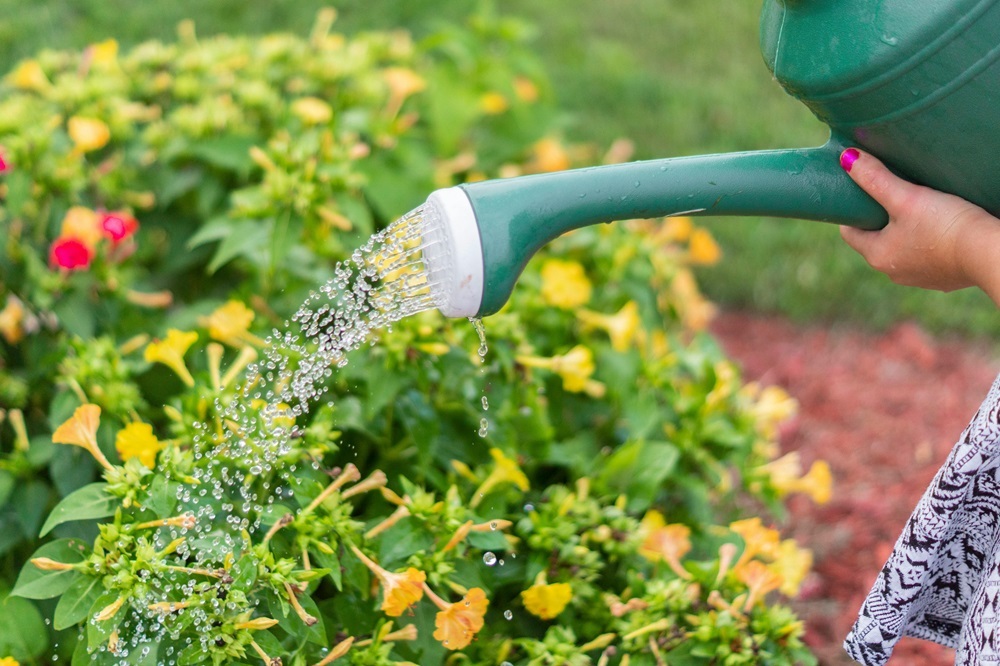Proper Watering Techniques for Hot Climate Gardens
May 11, 2010
How to water, especially when its hot
1. What time of day is best to water? As a general rule, how often and how deep should I water?
Early morning is the best time to water if you can. Watering during the evening or at night encourages fungal diseases on your turf and ornamentals. Watering during the middle of the day or afternoon can cause scorching. High soil temperatures also make it difficult for plants to take up water efficiently. When it comes to turf, the less often you water the better. Setting your sprinkler system for only 10 or 15minutes a day will do more harm than good. Shallow watering causes a shallow root system that is susceptible to disease and damage due to heat and cold. Water your turf about once a week for an hour early in the morning. In the heat of the summer you may need to increase to twice a week, but only if your grass is wilting (the blades will curl and it may have a bluish tint). Herbaceous ornamentals, such as your summer annuals, may need more frequent watering as summer progresses. Their root systems usually reach about 6to 12 inches deep, so check the surrounding soil every couple of days. Established trees and large shrubs only need supplemental watering during periods of drought, but newly planted trees should be watered frequently and deeply until they reach 2 to 3 years of age. Soaker or drip hoses are best used to keep your woody plants watered properly. Your goal is to deliver 1" of water per week to established plants. You can audit your irrigation system by using several small tuna cans. Place them in different irrigation zones and let them run till the cans are filled with 1" of water. Then you'll know how long to run each zone to deliver the right amount of water.

2. Sprinkler systems are expensive. Is it really worth the investment?
There are several reasons why a sprinklersystem may or may not be right for you. If your landscape contains mostly woody plants and herbaceousornamentals with little turf, you may want to stick with soaker-hoses/dripirrigation and hand watering. However, if you have an expansive lawn or youjust don’t have the time to water, a sprinkler system may be the way togo. Turf requires deep watering inorder to encourage a healthy root system. Hand watering or watering withmini-sprinklers usually doesn’t do the trick. A sprinkler system allows for proper and consistent watering with littleeffort. Because sprinkler systems arecontrolled automatically with timers, you can ensure your landscape won’t lievictim to drought while you’re on vacation in August! If you aren’t ready foran expensive underground sprinkler system, you may want to consider using anabove ground stand-alone pulsating sprinkler, such as a Rain Tower. Stand-alonesprinklers are several feet tall and connect to standard garden hoses. In the long run, a good sprinkler system canincrease the value of your home, which may make the investment a worthy one. Personally, I don't use an in-ground sprinkler system, but then perfect turf grass is not at the top of my garden priority list.
3. What kind ofmulch is superior for moisture retention?
Mostgardeners use organic mulches, which are derived from plant material, toconserve moisture in their landscape. Inorganic mulches include lava rocks, pebbles, plastic, or landscapefibers. Inorganic mulches can conservemoisture, but they do not break down to improve soil structure nor do they addnutrients. An important value of organic mulches is that they continuously addorganic matter to the soil surface in addition to conserving moisture. Homemade organic mulches can be produced byrecycling yard waste such as chopped or shredded leaves, wood chips, and drygrass clippings, or you can purchase mulches from your local gardencenter. Shredded hardwood or cedar mulch is anexcellent choice if you are going to purchase mulch. Mulch should be applied as a 2-5 inch layer on top of yourexisting soil. Over-mulching will limitair and water movement to the soil and cause disease, so make sure not to overdo it!
4. What is the trick to using soaker hoses?
Drip,trickle, or soaker hoses are ideal for use on woody plants, herbaceousornamentals, and vegetable gardens. Soaker hoses use less water thanconventional systems, such as the handy garden hose, operate at lower pressuresthan sprinkler systems, and save water by preventing run-off. Soaker hoses actually “sweat” water asopposed to spraying it into the air. The key to using soaker hoses is to bury them underneath your mulch.This not only holds the hoses in place, but also ensures that the moisturereaches the soil instead of getting trapped in the mulch. Soaker hoses are alsovery useful for keeping your foundation watered, which is crucial during ourhot dry summers. Place the soaker hosesalong the drip line of your home, or about 18 to 24” away from the foundation. You'll also need to run your soaker hoses much longer than you think, which may be several hours. Check the soil with your fingers to see how far the moisture has saturated within a given period of time.
5. Observe your local watering restrictions. In Dallas, restrictions run from March 1st through October 31st with no watering by automated systems between 10am-6pm every day. You may hand water with a hose or watering can during this time, but you cannot leave automated systems or above ground sprinklers running.

